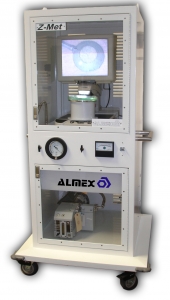
Z-MET™ is a vacuum gas & inclusion testing apparatus for molten aluminum.
Application
Z-MET™ analyzes the presence of dissolved hydrogen gas and inclusions inside molten aluminum on a qualitative real-time basis. Z-MET™ is used by process metallurgists when immediate knowledge of cleanliness of molten aluminum is required for quality control and process correction. The analyzer has application in plants which manufacture highly sophisticated aluminum alloys and MMCs for aerospace, defense, nuclear, automotive, and electronic industries.
Method of Testing
150 gms of molten aluminum (2” dia x 1” height) is collected in a specially designed crucible and vacuum chamber. The sample is solidified under ultra high vacuum generated very quickly in the solidifying chamber. The solidification process is viewed over a CTV screen. A video camera helps the operator to analyze the extent of hydrogen gas and the eruption of inclusions present in the sample. The Z-MET™ in-line test is extremely rapid and takes about 5 minutes from sample collection to completion of the test.
Z-MET Unit Specifications
-
Size: 42” (1060 mm) x 42” (1060 mm) x 72” (1828 mm)
-
Weight: 200 lbs (91 kg) on mobile base
-
Voltage: Available in 120/220 volts 50/60 Hz
-
Gas Detection: From 0.08 cc/100 gms to 0.42 cc/100 gms
-
Inclusions: From 20 microns to 3.0 mm qualitative
-
Process Consumables: None
Warranty
1 year parts and labor warranty, excluding the vacuum pump.
Application Background
Molten aluminum alloys contain four types of impurities:
-
Dissolved hydrogen gas
-
Inclusions (metallic & non-metallic)
-
Dissolved alkali & alkaline earth metals
-
Salts of alkali & alkaline earth metals